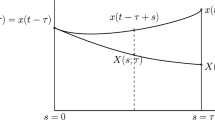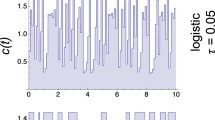Abstract
Thresholds for survival and extinction are important for assessing the risk of mortality in systems exposed to exogeneous stress. For generic, rudimentary population models and the classical resource-consumer models of Leslie and Gallopin, we demonstrate the existence of a survival threshold for situations where demographic parameters are fluctuating, generally, in a nonperiodic manner. The fluctuations are assumed, to be generated by exogenous, anthropogenic stresses such as toxic chemical exposures. In general, the survival threshold is determined by a relationship between mean stress measure in organisms to the ratio of the population intrinsic growth rate and stress response rate.
Similar content being viewed by others
Literature
Barber, M. C., L. A. Suarez and R. R. Lassiter 1988. “Kinetic Exchange of Nonpolar Organic Pollutants by Fish.”Envir. Tox. Chem., in press.
Dickson, K. L., A. W. Maki and J. Cairns Jr. 1982.Modeling the Fate of Chemicals in the Aquatic Environment, Ann Arbor, MI: Ann Arbor.
Freedman, H. I. and P. Waltman. 1985. “Persistence in a Model of Three Competitive Populations,”Math. Biosci 73, 89–101.
Gallopin, G. C. 1971. “A Generalized Model of Resource-Population System: I. General Properties. II. Stability Analysis.Oecologia 7, 382–413;7, 414–432.
Hallam, T. G. 1986. “Population Dynamics in Homogeneous Environment.” InMathematical Ecology: An Introduction, T. G. Hallam and S. A. Levin (Eds), pp. 61–94, Springer, New York.
—, Clark, C. E. and G. S. Jordan. 1983. “Effects of Toxicants on Populations: A Qualitative Approach. II. First Order Kinetics.”J. math Biol. 18, 25–37.
— and J. L. deLuna. 1984. “Effects of Toxicants on Populations: A Qualitative Approach. III. Environmental and Food Chain Pathways.J. theor. Biol. 109, 411–429.
—, R. R. Lassiter, J. Li and W. McKinney. 1988.Physiologically Structured Population Models in Risk Assessment. Biomathematics and Related Computational Problems, L. Ricciardi (Ed.), Amsterdam: Riedel.
— and Z. Ma 1986. “Persistence in Population Models with Demographic Fluctuations.J. math. Biol. 24, 327–339.
— and Z. Ma 1987. “On Density and Extinction in Continuous Population Models.J. math. Biol. 25, 191–201.
Hutchinson, G. E. 1978.An Introduction to Population Ecology. Yale: New Haven.
Leslie, P. H. 1984. “Some Further Notes on the Use of Matrices in Population Mathematics.”Biometrika 35, 213–245.
Ma, Z. and T. G. Hallam. 1987. “Effects of Parameter Fluctuations on Community Survival.Math. Biosci. 86, 35–49.
Moriarty, F. 1987.Ecotoxicology. New York: Academic Press.
Saxena, J. and F. Fisher (Eds), 1981.Harard Assessment of Chemicals. Current Developments, Vol. 1. New York: Academic Press.
Schultz, T. W., G. W. Holcombe and G. L. Phipps, 1986. “Relationships of Quantitative Structure-activity to Comparative Toxicity of Selected Phenols in thePimephales promelas andTetrahymena pyriformis Test Systems.”Ecotoxicol. Environ. Saf 12, 146–153.
Sheehan, P. J., P. R. Miller, G. C. Butler and P. Bourdeau (Eds). 1984.Effects of Pollutants at the Ecosystem Level. New York: Wiley.
Smith, F. E. 1963. “Population Dynamics inDaphnia magna and a New Model for Population Growth.Ecology 44, 651–663.
Veith, G. D., D. J. Call and L. T. Brooke. 1983. “Structure Toxicity Relationships for the Fathead Minnow,Pimephales promelas: Narcotic Industrial Chemicals.Can. J. Fish. Aquat. Sci. 40, 681–698.
Author information
Authors and Affiliations
Additional information
Research supported by the fund of Chinese Natural Science.
Research supported in part by the U.S. Enviromental Protection Agency under cooperative agreement CR-813353-01-0.
Rights and permissions
About this article
Cite this article
Zhien, M., Baojun, S. & Hallam, T.G. The threshold of survival for systems in a fluctuating environment. Bltn Mathcal Biology 51, 311–323 (1989). https://doi.org/10.1007/BF02460110
Received:
Revised:
Issue Date:
DOI: https://doi.org/10.1007/BF02460110




